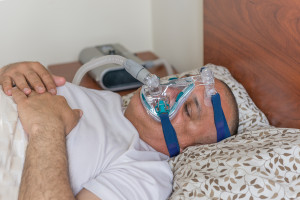Introduction
Sleep apnea is a special form of sleep disorder where there are pauses of breathing lasting longer than 10 seconds at a time, but throughout the night these occur frequently and as often as more than 20 times per hour.
It is fairly common in the general population with a rate of 2% to 4%. Also, males are afflicted with sleep apnea more commonly than women at a rate of 3 to1.
To the loved ones around these persons it can be a horrible experience as it sounds like the person has taken their last breath. The episodes occur as the airways through the nose and through the mouth cavities get closed off momentarily from the relaxation of the muscles that occurs during deep sleep in the tongue and the palate areas (see this image, thanks to medicineworld.org for this image).
As these episodes actually are accompanied by low blood oxygen levels, this condition can become life threatening, particularly with preexisting heart and lung disease. The death rate from heart attacks and strokes in this group of patients is about double, particularly in the older generation. As this condition is associated with obesity, and obesity has its own high risk for cardiovascular disease, the overall risk likely is even greater in the obese patient. There often are anatomical abnormalities in the palate and pharynx area that should be checked out by an ENT doctor. Family members (blood relatives) of sleep apnea patients and patients who snore have a 4-fold higher risk of also having this disease (Ref. 7, p.463).
Signs and Symptoms
Apart from frequent pauses of breathing sleep apnea patients often are also snoring. They may be tired and irritable during the day. They may cause car accidents frequently due to a lack of concentration as they are chronically sleep deprived. If there is a congenital minor malformation inside the nose, the pharynx, in the palate or of the uvula, this may affect other family members, but often people around them may get used to it or even perhaps perceive this as normal. High blood pressure is twice as common in patients with sleep apnea and snoring.
Diagnostic Tests
Sleep monitoring is at the center of accurate testing for sleep apnea. This is done with polysomnography, a sleep recording device that records simultaneously brain waves, rapid eye movements, muscle activity and a heart tracing(ECG).
Treatment
Essentially there are two treatments, medical and surgical. The medical treatment involves electromechanical devices such as continuous positive airway pressure (CPAP, see image above) etc. The surgical treatment involves excision of identifiable lesions such as a large uvula, soft palate reconstruction with laser assisted surgery and inner nasal surgeries (septoplasty)(thanks to www.snoring.com.au for this link), if necessary. The indicated links provide more detailed information.
Insomnia
Restoring sleep can be achieved by melatonin, which is a natural hormone produced by the pineal gland on the bottom of the brain (Ref.10). It is so well tolerated that the FDA decided to allow this to be sold in drug stores and health food stores without a prescription. Most people need between 1mg to 9 mg of melatonin at bedtime. It is a powerful antioxidant hormone and helps other hormones to work more efficiently.
References:
1. Noble: Textbook of Primary Care Medicine, 3rd ed., Copyright © 2001 Mosby, Inc.
2. National Asthma Education and Prevention Program. Expert Panel Report II. National Heart, Lung and Blood Institute, 1997.
3. Rakel: Conn’s Current Therapy 2002, 54th ed., Copyright © 2002 W. B. Saunders Company
4. Murray & Nadel: Textbook of Respiratory Medicine, 3rd ed., Copyright © 2000 W. B. Saunders Company
5. Behrman: Nelson Textbook of Pediatrics, 16th ed., Copyright © 2000 W. B. Saunders Company
6. Merck Manual : Sleep Apnea (thanks to www.merckmanuals.com for this link)
7. Goldman: Cecil Textbook of Medicine, 21st ed., Copyright © 2000 W. B. Saunders Company
8. Ferri: Ferri’s Clinical Advisor: Instant Diagnosis and Treatment, 2004 ed., Copyright © 2004 Mosby, Inc.
9. Rakel: Conn’s Current Therapy 2004, 56th ed., Copyright © 2004 Elsevier







